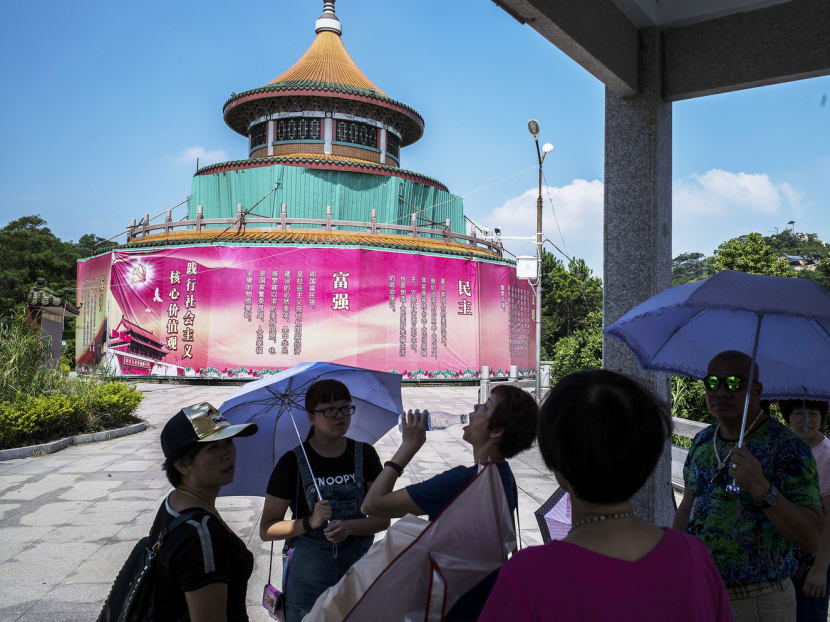Fate catches up with a Cultural Revolution museum in China
SHANTOU (China) — The idea to build China’s first museum dedicated to the Cultural Revolution — the political campaign begun by Mao Zedong that killed more than a million people — was always risky.

Visitors at a museum about China’s Cultural Revolution in Shantou, China. The museum, about the political campaign begun by Mao Zedong, became a reality through donations. The memorial was recently covered up. Photo: The New York Times
SHANTOU (China) — The idea to build China’s first museum dedicated to the Cultural Revolution — the political campaign begun by Mao Zedong that killed more than a million people — was always risky.
Yet Mr Peng Qi’an, a former local Communist Party official and the museum’s founder, spent two decades scraping together donations from private individuals and local government departments to create the Cultural Revolution Museum, which opened in the rolling hills of the Chenghai Pagoda Scenic Area in 2005.
Amid yellow pagodas pointing heavenward, Mr Peng and a small group of volunteers built memorial arches across the park’s steep roads and paths lined with riotous subtropical vegetation.
The site, in the Chenghai district of Shantou, was an appropriate place for memory. Buddhist pagodas are associated with the dead, and many local victims of the Cultural Revolution lie here, many buried in mass graves.
They raised a statue of Liu Shaoqi, a former president persecuted by Mao who died in prison in 1969, and of Marshal Ye Jianying, a military leader from Guangdong province, where Shantou is situated. Scholars and relatives of victims across China donated stones engraved with stories and admonitions. “The 10 years of hardship alarm the ghosts and gods,” ran one inscription on a wall.
The museum’s centrepiece, a stately building of green, red and yellow tiles, described the brutality of the campaign in documents and photographs. Then, signs appeared in late April, a few weeks before the 50th anniversary of the start of the Cultural Revolution: “Because of the need to adjust the function of the park, repairs will be carried out.”
Workers arrived bearing concrete, propaganda banners and metal scaffolding. They smoothed concrete over the names of victims, wrapped “Socialist Core Values” banners around the main exhibition hall, placed red-and-yellow propaganda posters over stone memorials to the terror, and raised scaffolding around statues of critics of Mao.
The literal cover-up took Mr Peng by surprise.“We built this museum in good faith,” he said. “We wanted to mourn the dead, to remember the history, to learn lessons from it, and never let the tragedy of the Cultural Revolution happen again.”
While the Communist Party disavows the revolution’s 10 years of turmoil, it also bans free public debate about it. Instead it seeks to uphold its own judgment, from 1981, that Mao made “gross mistakes” in the Cultural Revolution, but that “his merits are primary and his errors secondary”.
Dressed in a white singlet, blue-and-white pajama pants and brown plastic sandals, Mr Peng said he believed that the order to cover up the museum was not local, but had come from “higher up.” He declined to discuss the matter further.
The wintry mood that has shuttered the museum is in line with a broader political tightening under President Xi Jinping, whose tenure has included appeals to Maoist-style ideological purity, a concentration of authority in his person and crackdowns on dissent.
The cover-up was breathtakingly thorough. Along a winding hill road, a giant concrete wall that bore the somber words “Soul Garden Pagoda” now sports an upbeat party slogan: “China Dream.”
The propaganda banners around the main hall advocating values like patriotism and justice entomb the exhibits inside. “Everything is locked up in the main museum building, and now it’s shut,” Mr Peng said.
The golden statue of Marshal Ye, who is credited with helping end the Cultural Revolution upon Mao’s death in 1976, stands encased in metal sheets, discolouring in the dark. Scaffolding blocks access to the statue of President Liu on a large, open-air platform, where people mourned.
More than 400 people were killed and 5,000 were injured in factional fighting in the Chenghai district alone, according to a history published by the local party committee. One of the victims was 46-year-old Lin Hua, Mr Peng’s older brother and a dean at Chenghai High School, who was buried here in 1967, Mr Peng said.
Faced with the collapse of decades of work, Mr Peng appeared bewildered, eager to point out that the museum had been memorial, not political, in intent. The museum was “completely simple and in line with the party’s definition” of those times, he said. “We had no other intentions.”
At the bottom of a hill by a reservoir where people rent pedal boats, a heart-shaped stone the size of an armchair rests against scrubby trees.
A yellow-and-red plastic sign stretched across it reads: “Socialist Core Values”, obscuring a different message underneath, said a middle-aged man working at a food stall nearby.
“It said: ‘Those who live in our hearts live forever,’” he said, before walking away without giving his name. THE NEW YORK TIMES





